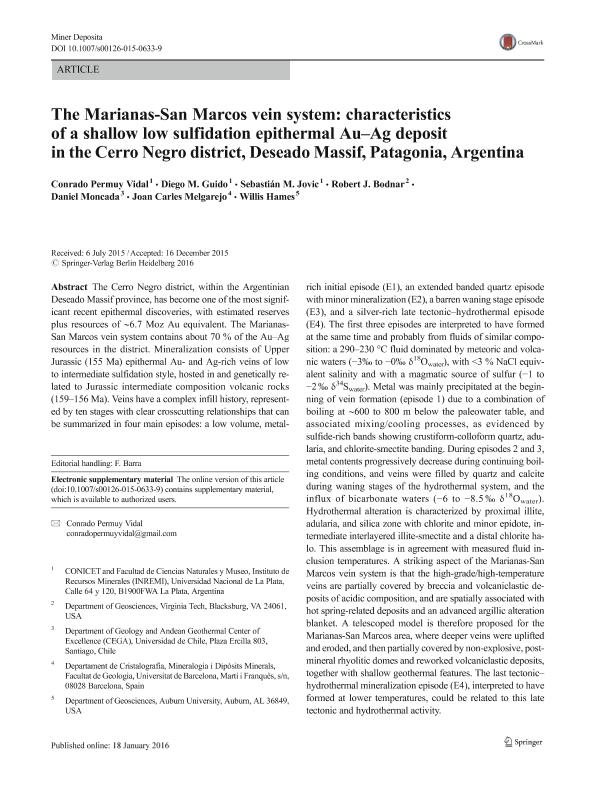Mostrar el registro sencillo del ítem
dc.contributor.author
Permuy Vidal, Conrado

dc.contributor.author
Guido, Diego Martin

dc.contributor.author
Jovic, Sebastian Miguel

dc.contributor.author
Bodnar, Robert J.
dc.contributor.author
Moncada, Daniel
dc.contributor.author
Melgarejo, Joan Carles
dc.contributor.author
Hames, Willis
dc.date.available
2019-03-29T15:23:34Z
dc.date.issued
2016-08
dc.identifier.citation
Permuy Vidal, Conrado; Guido, Diego Martin; Jovic, Sebastian Miguel; Bodnar, Robert J.; Moncada, Daniel; et al.; The Marianas-San Marcos vein system: characteristics of a shallow low sulfidation epithermal Au-Ag deposit in the Cerro Negro district, Deseado Massif, Patagonia, Argentina; Springer; Mineralium Deposita; 51; 6; 8-2016; 725-748
dc.identifier.issn
0026-4598
dc.identifier.uri
http://hdl.handle.net/11336/72822
dc.description.abstract
The Cerro Negro district, within the Argentinian Deseado Massif province, has become one of the most significant recent epithermal discoveries, with estimated reserves plus resources of ∼6.7 Moz Au equivalent. The Marianas-San Marcos vein system contains about 70 % of the Au–Ag resources in the district. Mineralization consists of Upper Jurassic (155 Ma) epithermal Au- and Ag-rich veins of low to intermediate sulfidation style, hosted in and genetically related to Jurassic intermediate composition volcanic rocks (159–156 Ma). Veins have a complex infill history, represented by ten stages with clear crosscutting relationships that can be summarized in four main episodes: a low volume, metal-rich initial episode (E1), an extended banded quartz episode with minor mineralization (E2), a barren waning stage episode (E3), and a silver-rich late tectonic–hydrothermal episode (E4). The first three episodes are interpreted to have formed at the same time and probably from fluids of similar composition: a 290–230 °C fluid dominated by meteoric and volcanic waters (−3‰ to −0‰ δ 18 O water ), with <3 % NaCl equivalent salinity and with a magmatic source of sulfur (−1 to −2 ‰ δ 34 S water ). Metal was mainly precipitated at the beginning of vein formation (episode 1) due to a combination of boiling at ∼600 to 800 m below the paleowater table, and associated mixing/cooling processes, as evidenced by sulfide-rich bands showing crustiform-colloform quartz, adularia, and chlorite-smectite banding. During episodes 2 and 3, metal contents progressively decrease during continuing boiling conditions, and veins were filled by quartz and calcite during waning stages of the hydrothermal system, and the influx of bicarbonate waters (−6 to −8.5 ‰ δ 18 O water ). Hydrothermal alteration is characterized by proximal illite, adularia, and silica zone with chlorite and minor epidote, intermediate interlayered illite-smectite and a distal chlorite halo. This assemblage is in agreement with measured fluid inclusion temperatures. A striking aspect of the Marianas-San Marcos vein system is that the high-grade/high-temperature veins are partially covered by breccia and volcaniclastic deposits of acidic composition, and are spatially associated with hot spring-related deposits and an advanced argillic alteration blanket. A telescoped model is therefore proposed for the Marianas-San Marcos area, where deeper veins were uplifted and eroded, and then partially covered by non-explosive, post-mineral rhyolitic domes and reworked volcaniclastic deposits, together with shallow geothermal features. The last tectonic–hydrothermal mineralization episode (E4), interpreted to have formed at lower temperatures, could be related to this late tectonic and hydrothermal activity.
dc.format
application/pdf
dc.language.iso
eng
dc.publisher
Springer

dc.rights
info:eu-repo/semantics/openAccess
dc.rights.uri
https://creativecommons.org/licenses/by-nc-sa/2.5/ar/
dc.subject
Argentina
dc.subject
Epithermal
dc.subject
Jurassic
dc.subject
Patagonia
dc.subject
Quartz Vein
dc.subject.classification
Paleontología

dc.subject.classification
Ciencias de la Tierra y relacionadas con el Medio Ambiente

dc.subject.classification
CIENCIAS NATURALES Y EXACTAS

dc.title
The Marianas-San Marcos vein system: characteristics of a shallow low sulfidation epithermal Au-Ag deposit in the Cerro Negro district, Deseado Massif, Patagonia, Argentina
dc.type
info:eu-repo/semantics/article
dc.type
info:ar-repo/semantics/artículo
dc.type
info:eu-repo/semantics/publishedVersion
dc.date.updated
2019-03-21T14:33:47Z
dc.identifier.eissn
1432-1866
dc.journal.volume
51
dc.journal.number
6
dc.journal.pagination
725-748
dc.journal.pais
Alemania

dc.journal.ciudad
Berlin
dc.description.fil
Fil: Permuy Vidal, Conrado. Universidad Nacional de La Plata. Facultad de Ciencias Naturales y Museo. Instituto de Recursos Minerales. Provincia de Buenos Aires. Gobernación. Comisión de Investigaciones Científicas. Instituto de Recursos Minerales; Argentina. Consejo Nacional de Investigaciones Científicas y Técnicas; Argentina
dc.description.fil
Fil: Guido, Diego Martin. Universidad Nacional de La Plata. Facultad de Ciencias Naturales y Museo. Instituto de Recursos Minerales. Provincia de Buenos Aires. Gobernación. Comisión de Investigaciones Científicas. Instituto de Recursos Minerales; Argentina. Consejo Nacional de Investigaciones Científicas y Técnicas; Argentina
dc.description.fil
Fil: Jovic, Sebastian Miguel. Universidad Nacional de La Plata. Facultad de Ciencias Naturales y Museo. Instituto de Recursos Minerales. Provincia de Buenos Aires. Gobernación. Comisión de Investigaciones Científicas. Instituto de Recursos Minerales; Argentina. Consejo Nacional de Investigaciones Científicas y Técnicas; Argentina
dc.description.fil
Fil: Bodnar, Robert J.. Virginia Tech University; Estados Unidos
dc.description.fil
Fil: Moncada, Daniel. Universidad de Chile; Chile
dc.description.fil
Fil: Melgarejo, Joan Carles. Universidad de Barcelona; España
dc.description.fil
Fil: Hames, Willis. Auburn University; Estados Unidos
dc.journal.title
Mineralium Deposita

dc.relation.alternativeid
info:eu-repo/semantics/altIdentifier/doi/http://dx.doi.org/10.1007/s00126-015-0633-9
dc.relation.alternativeid
info:eu-repo/semantics/altIdentifier/url/https://link.springer.com/article/10.1007%2Fs00126-015-0633-9
Archivos asociados
